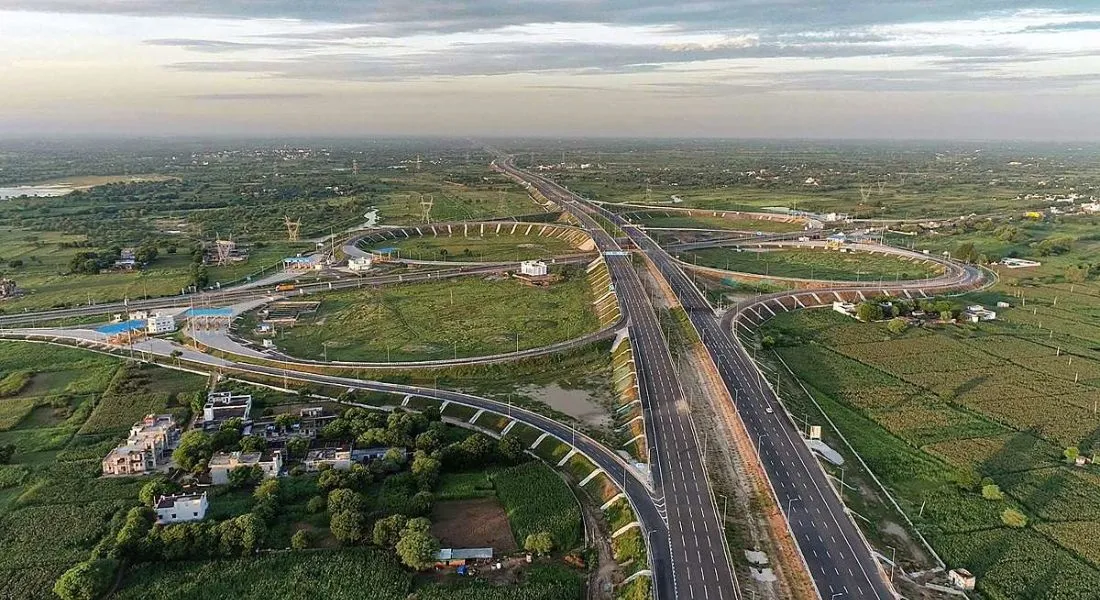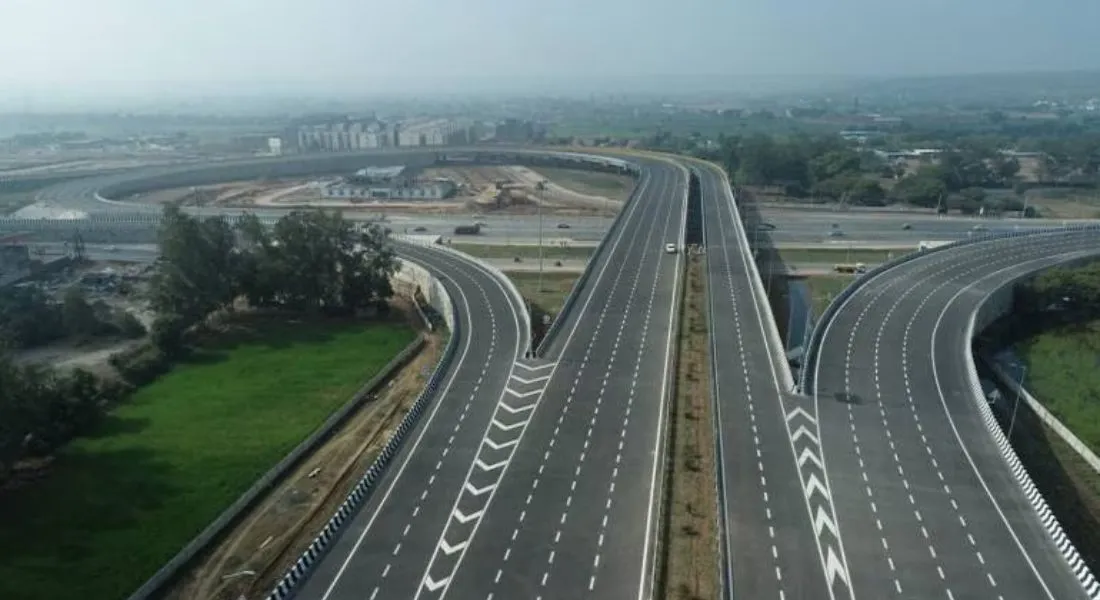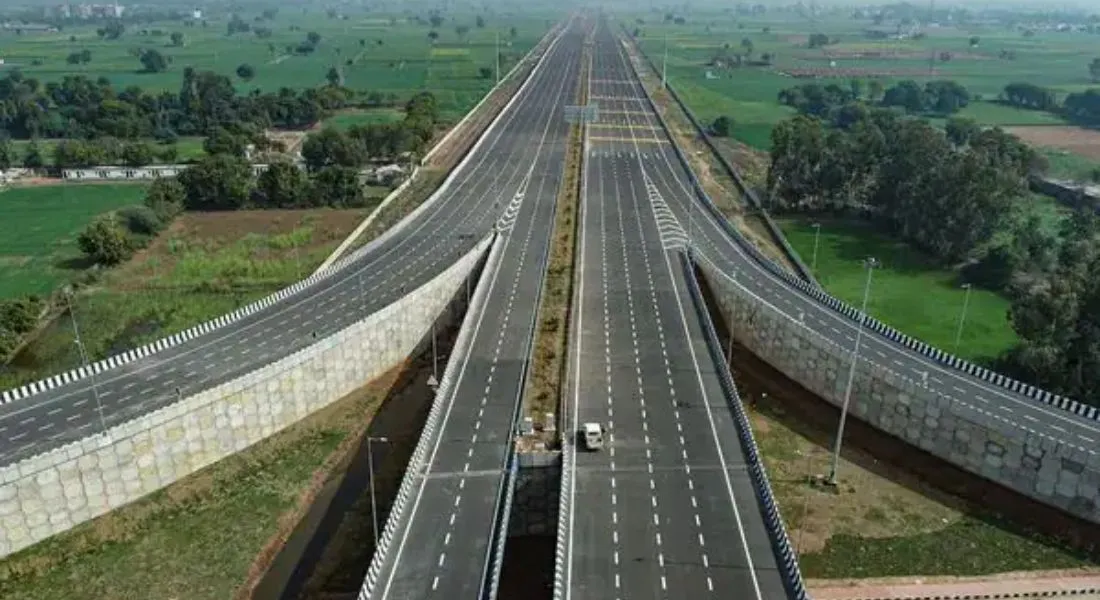Delhi Mumbai Expressway | Latest Updates, Completition Date, Route Map, Toll Charges & More
The Delhi Mumbai Expressway is the first of its kind, a greenfield road that directly connects the capital of India, Delhi, with the financial capital of India, Mumbai. It is a 12-lane, under-construction (partially opened) expressway maintained by the NHAI (National Highway Authority of India).
It will reduce the travel time between Mumbai and Delhi from 24 to 12 hours. It will definitely help reduce travel time, fuel consumption, and effort. The Delhi-Mumbai Expressway’s total length is 1350km.
Prime Minister Narendra Modi inaugurated the Sohna-Dausa stretch of the Delhi Mumbai expressway on February 12, 2023. Union Minister Gajendra Singh Shekhawat, Nitin Gadkari, and VK Singh were also present at the inauguration.
It will connect major economic hubs in Delhi, Haryana, Rajasthan, Madhya Pradesh, Gujarat, and Maharashtra. This seamless connectivity is expected to boost trade and commerce between these regions.
The expressway incorporates several green initiatives, including solar power generation and rainwater harvesting systems. It is also designed with advanced safety features, such as intelligent traffic management systems and crossing wildlife, to minimize accidents and protect the environment.
The Delhi Mumbai Expressway is a significant infrastructure project providing a direct and efficient road link between Delhi and Mumbai, two of India’s most important cities. Union Road Trasport & Highway Minister Shri Nitin Gadkari laid the foundation of this project in March 2019.
What is the Route of New Delhi Mumbai Expressway?
This route will pass through five significant Indian states: Haryana, Rajasthan, Gujarat, Madhya Pradesh, and Maharashtra.
Here’s an overview of the expressway route:
Starting Point: This expressway begins at Sohna, near Gurugram, Haryana, a short distance from south Delhi.
Ending Point: This expressway finishes at Mumbai, Maharashtra, specifically near Jawaharlal Nehru Port Trust (JNPT), facilitating access to India’s largest container port.
Delhi Mumbai Expressway Key Route Details
1. Haryana: The expressway starts in Sohna, Gurugram district, and passes through districts like Palwal and Nuh.
2. Rajasthan: Entering Rajasthan, the expressway passes through several key areas, including Alwar, Bharatpur, Dausa, and Kota. This segment is designed to improve connectivity to these regions’ industrial hubs.
3. Madhya Pradesh: In Madhya Pradesh, the route moves through Mandsaur, Ratlam, and Jhabua. This part of the route is significant for linking the central parts of India with the expressway.
4. Gujarat: The expressway enters Gujarat and covers essential areas like Dahod, Vadodara, and Bharuch. Vadodara is a major junction where the expressway intersects with other significant highways.
5. Maharashtra: The final leg of the journey runs through Maharashtra, entering via Valsad and proceeding towards Mumbai. It connects to the Mumbai Metropolitan Region, specifically reaching close to the Jawaharlal Nehru Port Trust (JNPT).
Also Read: What is RERA? All About RERA Act 2016
Key Features of Mumbai Delhi Expressway Route
Here are the highlights of the Delhi-Mumbai Expressway route:
- Length: The expressway spans approximately 1,386 kilometres, making it one of the longest expressways in India.
- States Covered: The route passes through six states: Delhi, Haryana, Rajasthan, Madhya Pradesh, Gujarat, and Maharashtra.
- Key Cities Connected: Major cities along the route include Delhi, Gurugram, Jaipur, Kota, Ratlam, Vadodara, and Mumbai.
- Construction and Cost: The Delhi-Mumbai Expressway, which involves state-of-the-art construction techniques, is estimated to be around INR 1 lakh crore (USD 13.6 billion).
- Reduction in Travel Time: The expressway is designed to reduce the travel time between Delhi and Mumbai to approximately 12-13 hours from the current 24 hours.
- Economic Corridors: The route will boost economic activities by connecting major industrial hubs and SEZs (Special Economic Zones).
- Interchanges and Connectivity: It includes several interchanges for better connectivity to various towns and cities, improving regional accessibility.
- Environmental Considerations: The expressway incorporates eco-friendly measures, including wildlife crossings and sound barriers in sensitive areas.
- Advanced Features: Equipped with advanced traffic management systems, emergency response systems, and helipads for medical emergencies.
- Service Facilities: The route features numerous service areas providing amenities such as fuel stations, rest areas, restaurants, and repair services.
- Landscaping and Aesthetics: Emphasis on landscaping with extensive tree plantation along the corridor to enhance environmental sustainability and aesthetics.
- Digital Infrastructure: Provision of digital infrastructure like optical fibre cables for high-speed internet connectivity along the route.
- Future Expansion: Plans for expansion and connections to other major expressways and highways to further improve the national road network.
Also Read: Best two colour combination for Beedroom walls with images
What will the impact of the Mumbai Delhi Expressway be?
- Travel Time: The expressway will reduce the travel time between Delhi and Mumbai from the current 24 hours to about 12 hours.
- Economic Growth: Improving logistics and connectivity will enhance trade and commerce between India’s northern and western parts.
- Regional Development: Townships, industrial corridors, and logistic parks are planned along the route, fostering regional Growth.
The Delhi-Mumbai Expressway is a transformative project that will improve connectivity between Delhi and Mumbai, stimulate economic growth, improve logistics, and contribute to sustainable development.
Also Read: 10 Biggest cities in India
Delhi Mumbai Expressway Route Map
Here is the route map of Delhi Mumbai Expressway connecting India’s five major states.
Delhi Mumbai Expressway State Wise Route
Delhi mumbai expressway passes through 5 states Haryana, Rajasthan, Madhya Pradesh, Gujarat, Maharashtra.
Here is the state wise length of Delhi Mumbai expressway route.
| Names of States | Route Length |
| Haryana | 80 Kms |
| Rajasthan | 380 Kms |
| Maharashtra | 120 Kms |
| Gujarat | 300 Kms |
| Madhya Pradesh | 370 Kms |
Mumbai Delhi Expressway Route in Haryana
Here is the Delhi Mumbai Expressway Route in Haryana.
| Route | Location |
| Flyover Interchange on NH-919 | Bhirawati Village in Sohna |
| Flyover Interchange between Nuh-Hodal and Nuh-Ujina Link | MDR (Major District Road) 132 |
| Cloverleaf Interchange on Western Peripheral Expressway | Near Khalilpur Village in Gurgaon |
| Interchange between Bhadas and Hathin | Bhadas, MDR (Major District Road) 135 |
| Flyover Interchange on the Mooltan-Hodal Section | West of Pinangwan, MDR (Major District Road) 131 |
| Flyover Interchange on NH 22 | East of Ferozepur Jhirka |
| Kolgaon, South of Ferozpur Jhirka | Haryana-Rajasthan Border |
Delhi Mumbai Expressway Route in Rajasthan
Here is the Delhi Mumbai Expressway Route in Rajasthan.
| Route | Location |
| NH45, NH14, and NH44 Interchanges | Alwar |
| Interchange at NH25A | Rajgarh |
| Interchange on Manoharpur-Dausa Highway | NH148 |
| NH21 and NH23 Intersections | Jaipur |
| Indragarh Interchange | NH29 |
| Interchange South-West of Sawai Madhopur | NH552 |
| NH34, NH52, and NH27 Interchanges | Kota |
| Rawatbhata Interchange | NH9A |
| Neemuch Interchange | NH31A |
Also Read: 10 Most Amazing Haldi Decoration Ideas at home
Delhi Mumbai Expressway Route In Gujarat
Here is the Delhi Mumbai Expressway Route in Gujarat.
| Route | Location |
| Dahod | Chhayan Village |
| Vadodara | |
| Godhra | |
| Surat | |
| Navsari | |
Delhi Mumbai Expressway Route in Madhya Pradesh
Here is the Delhi Mumbai Expressway Route in Madhya Pradesh.
| Route | Location |
| Interchange East of Bhanpura-Neemuch | |
| East of Garoth | |
| NH31 and NH14 Interchanges | Mandsaur |
| Jaora | |
| Ratlam and Banswara | |
| Thandla | |
Delhi Mumbai Expressway Route in Maharashtra
Here is the Delhi Mumbai Expressway Route in Maharashtra
| Route | Location |
| Vapi-Silvassa | |
| Valsad | |
| Virar | Palghar |
| Amane-Badlapur | Thane |
| JawaharLal Nehru Port | Navi Mumbai |
What is the Toll Price of the Delhi Mumbai Expressway?
After the inauguration of this expressway, NHAI will allow the collection of toll tax from vehicles, and it will be fixed for a fixed distance.
According to NHAI officials, the toll rates in Rajasthan and Haryana will be the same. It will charge ₹90 for a distance of 19.8 km. The maximum charges will be calculated based on distance.
Delhi Mumbai Expressway Toll Price List
| Vehicle | Khalilpur | Shamsabad | Seetal | Pinan | Bhandrej | Durgapur | Barka Pass |
| Light | 90 | 175 | 240 | 290 | 395 | 460 | 500 |
| Light (Commercial) | 145 | 280 | 390 | 465 | 640 | 740 | 805 |
| Bus/Truck (2 axle) | 300 | 590 | 815 | 960 | 1345 | 1550 | 1680 |
| Bus/Truck (3 axle) | 330 | 645 | 8901 | 1065 | 1465 | 1690 | 1840 |
| 6 axle vehicles | 475 | 925 | 1280 | 1535 | 2110 | 2430 | 2645 |
| 7 Axle or More | 575 | 1125 | 1555 | 1865 | 2566 | 2960 | 3215 |
Also Read – TOP 10 Best Window Grill Design Ideas
Delhi Mumbai Expressway Images



Delhi Mumbai Expressway Rules and Regulations
The Delhi-Mumbai Expressway has several rules and regulations to ensure safety, smooth traffic flow, and efficient operation. Here are the fundamental rules and regulations:
Speed Limits
- Cars and Light Vehicles: The maximum speed limit of Delhi Mumbai Expressway is approx. 120 km/h.
- Heavy Vehicles: The maximum speed limit is around 80 km/h.
- Variable Speed Limits: Speed limits may vary in certain sections, especially near interchanges, urban areas, and curves.
Lane Discipline
- Lane Usage: Strict adherence to lane discipline is required. Fast lanes (rightmost lanes) are reserved for overtaking, while slower lanes (leftmost lanes) are for trucks and slower vehicles.
- No Overtaking Zones: Overtaking is prohibited in designated areas such as sharp curves, interchanges, and underpasses.
Toll Payment
- Electronic Toll Collection: Toll payment requires the use of FASTag, which facilitates quicker transactions and reduces congestion at toll plazas.
- Toll Receipts: Keep toll receipts handy as proof of payment.
Vehicle Fitness and Documentation
- Valid Documents: Vehicles must have valid registration, insurance, and pollution under control (PUC) certificates.
- Vehicle Condition: Vehicles should be in good condition, with functioning lights, indicators, and brakes.
Prohibited Activities
- Pedestrians and Non-Motorized Vehicles: Pedestrians, bicycles, and other non-motorized vehicles are prohibited on this expressway.
- Stopping and Parking: Stopping or parking on the expressway, except in designated areas, is not allowed.
- Overloading: Vehicles should be within the prescribed weight limits.
Environmental and Noise Regulations
- Sound Pollution: Honking is discouraged to minimize noise pollution. Use horns only when necessary.
- Littering: Throwing trash or littering on the expressway is prohibited. Use designated bins and disposal areas.
Surveillance and Enforcement
- CCTV Monitoring: The expressway is equipped with CCTV cameras to monitor traffic and enforce rules.
- Fines and Penalties: If you violate traffic rules like speed limits and other regulations, you must pay fines and penalties as per the Motor Vehicles Act.
Additional Facilities and Services
- Rest Areas: Utilize rest areas for breaks to avoid fatigue. These areas offer food, restrooms, and fuel stations.
- Medical Emergencies: Helipads and ambulance services are available for medical emergencies.
Also Read: Top 10 Tallest Building in India
Delhi Mumbai Expressway Completion Date
The completion of the Delhi Mumbai Expressway is scheduled for December 2024. According to the latest reports, the complete section of this expressway will be operational in December 2024.
What are the interchanges on the Delhi-Mumbai Expressway?
The Mumbai-Delhi Expressway features several key interchanges to enhance connectivity across various regions. Here are some of the significant interchanges on the Delhi-Mumbai Expressway.
1. Delhi-NCR
- DND Flyway (Delhi)
- Faridabad
- Ballabhgarh
- Sohna
2. Rajasthan
- Jaipur
- Kishangarh
- Ajmer
- Kota
- Alwar
3. Madhya Pradesh
- Ratlam
- Mandsaur
- Ujjain
- Indore
4. Gujarat
- Vadodara
- Bharuch
- Surat
5. Maharashtra
- Virar
- Jawaharlal Nehru Port Trust (JNPT)
FAQs
Which cities are covered by Delhi Mumbai Expressway?
This Expressway covers six states: Delhi, Haryana, Madhya Pradesh, Gujarat, Rajasthan, and Maharashtra.
What is the speed limit on Mumbai Expressway?
The speed limit of the Delhi-Mumbai Expressway is 120 km/hr for most routes.
Are Bikes allowed on Delhi Mumbai Expressway?
No, bikes are not allowed on the Delhi Mumbai Expressway.
How much time will it take to complete Delhi Mumbai Expressway?
As per the reports, this expressway will completed by December 2024.
Is Delhi to Mumbai Expressway open?
Delhi-Mumbai Expressway is open, but the entire route will be operational by December 2024.
How many kilometers is the Delhi Mumbai Expressway?
The Mumbai-Delhi expressway is a 1386km long expressway.
What are the benefits of Delhi Mumbai Expressway?
The main benefits of the Delhi-Mumbai Expressway are that it will reduce the time spent travelling between Delhi and Mumbai, reduce fuel consumption, and help boost the economy.
How many lanes are in the Delhi Mumbai Expressway?
There are 12 lanes on Delhi-Mumbai Expressway.
What is the ending point of Delhi-Mumbai Expressway?
The ending point of the Delhi-Mumbai Expressway is JNPT, Mumbai.

